Like many others, I am a lover of the artwork of the Dutch Golden Age painters. The Dutch Golden Age was a period in the history of the Netherlands, which spanned the era from 1588 and the birth of the Dutch Republic to 1672, Rampjaar (Disaster Year) which was the year of the outbreak of the Franco-Dutch War. During this period, it was considered that Dutch trade, science, and art and the Dutch military were among the most acclaimed in Europe. We all know about the lives and works of the famous artists of that era, such as Rembrandt, Vermeer, Jan Steen, Frans Hals and Judith Leyster to name but a few. In my blog today I want to look at the lives and works of the lesser-known painters of that era.
Izaak van Oosten was a Flemish Baroque landscape and cabinet painter who worked out of Antwerp. Izaak was born in Antwerp in December 1613 and was the son of an art dealer with the same name. His father had become a master in the Antwerp Guild of St. Luke in 1617. Very little is known about his upbringing or his early artistic training as there is no record of which master or masters he studied under. Izaak became a master in the Antwerp Guild of St. Luke in 1652.
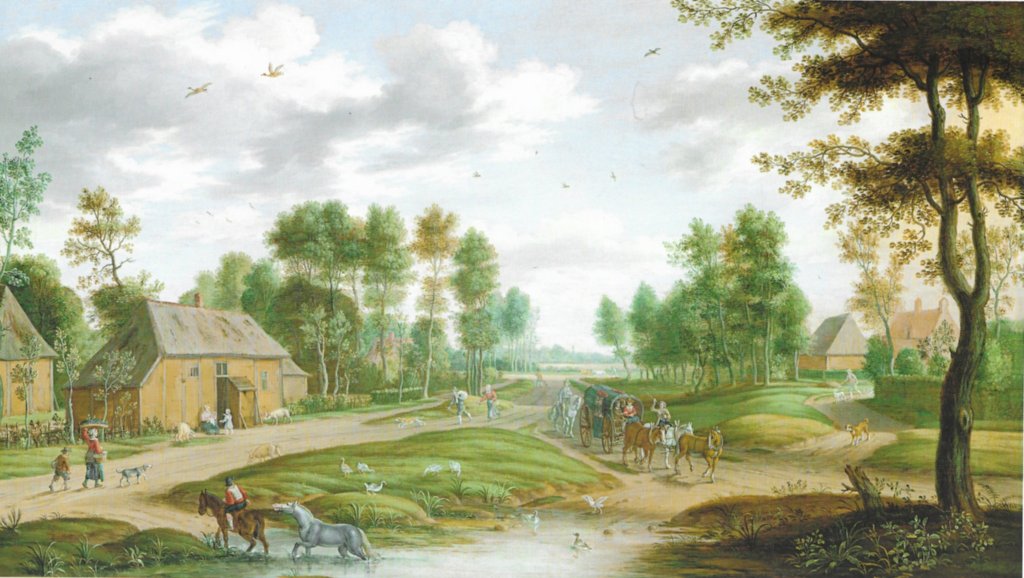
There is something joyful about paintings depicting skaters on frozen rivers and lakes. It is all before global warming and I am sure that now, many of the rivers and lakes retain their fluidity even in the depths of winter. The painting I am showcasing is entitled Skaters on a Frozen Lake at the Edge of Town and it was painted by the Dutch Golden Age landscape painter Cornelis Beelt. Cornelis Beelt was a Dutch Golden Age landscape painter who was one of the chief figures in the Haarlem school of landscape painting, but was also well-known for his genre paintings of towns, markets and villages. Beelt was born in Haarlem during the first decade of the seventeenth century.
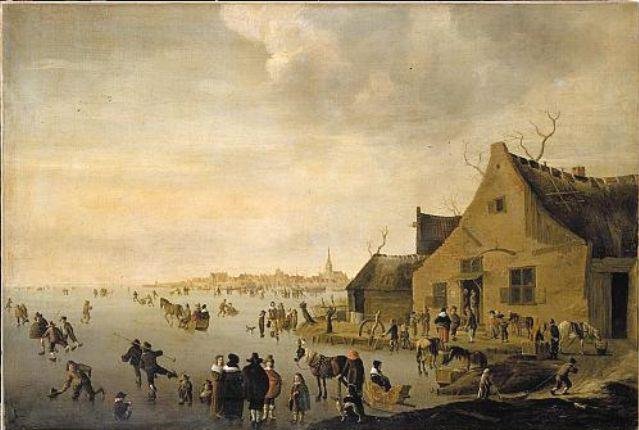
The setting is a clear winter’s day and crowds of locals gather besides a country inn keen to enjoy the sport on the ice. Young and old, rich and poor are attracted to this pastime. In the foreground a group of well-dressed men and women stands on the ice and chat. An old lady with her hands in a fur muff sits in a splendid arreslee (sleigh which is drawn by a horse and which is decorated with a fine plumed harness. Close by young children propel themselves across the ice on small prikslees (sledges).
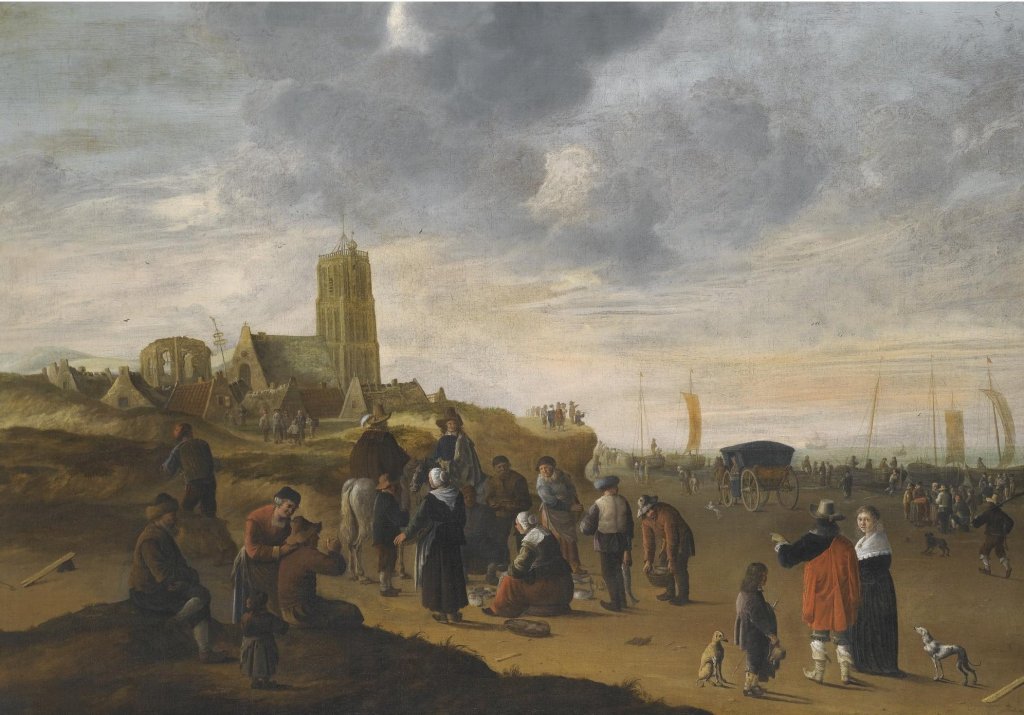
There is a strange thing about this painting which unfortunately is not visible from the attached picture. Beelt signed his painting in an unusual manner, one which he had also done on his painting Beach of Shevingen. He signed his name on the plank of wood in the foreground. However , at a later time, his signature was scrubbed out and replaced by the inscription J.V.Ostade f.1653 and this was judged to be an attempt by a less than honest art dealer to ascribe the work to a more famous name, Isaac van Ostade, so as to have a better chance of selling the painting, even though Ostade had died in 1649 !
The phrase ‘cabinet d’amateur’, in French, is an ancient term which referred to a room or part of a room in an art collector’s house where he or she displayed the paintings they had purchased. These display areas were before the rise of public galleries. Some where simple cabinets which contained their owner’s beloved works and some where floor to ceiling displays of their paintings. The phrase cabinet d’amateur should not be viewed as that of an “amateur collector” but that of an “art lover”. A German term for such a place is often referred to as a kunstkammer. In Italian it might be called a Gabinetto, Studiolo or Camerino.
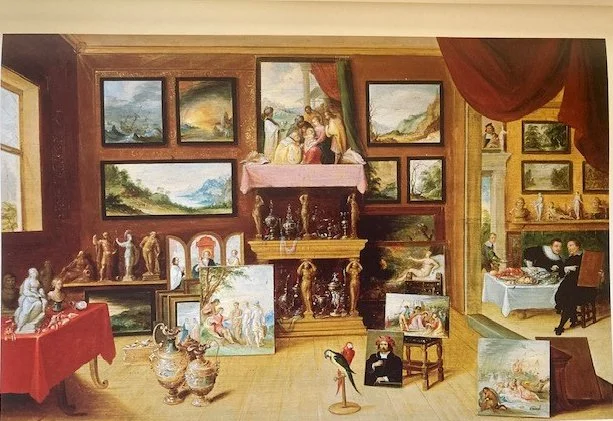
The painting connected with this term is one by the Flemish painter, Frans Francken the Younger and described as Two collectors dining in a gallery surrounded by paintings and works of art, with two parrots in the foreground. Frans Francken the Younger was the most famous of an Antwerp dynasty of painters; he trained with his father, Frans the Elder, and joined the Antwerp guild in 1605. He was a painter of religious and historical subjects as well as being the inventor of the genre – the cabinet painting.
On the right-hand side of the painting we see two men deep in discussion about a painting one of them is holding up but we do not know who is the owner of this kunstkammer. The presence of a kunstkammer in one’s house was a sign of wealth, intelligence and social status. In the main part of the painting, we see an ornate sideboard supported by classical caryatids. A caryatid is the name given to a sculpted female figure serving as an architectural support taking the place of a column or a pillar supporting an entablature on her head. A light-pink fringed cloth covers the top shelf of the sideboard on which two large shells are placed either side of the painting, The Adoration of the Magi. Richly decorated goblets and covered urns are displayed on two of the sideboard shelves. On the floor we see two parrots depicted sitting on a perch. The import of exotic foreign birds testified to the owner’s wealth. We see a large red velvet curtain falls from the ceiling which when released would act as a separator of the two rooms. Everything in the room exudes the wealth of the owner which would have been the raison d’être for the owner of the cabinet d’amateur commissioning the work.
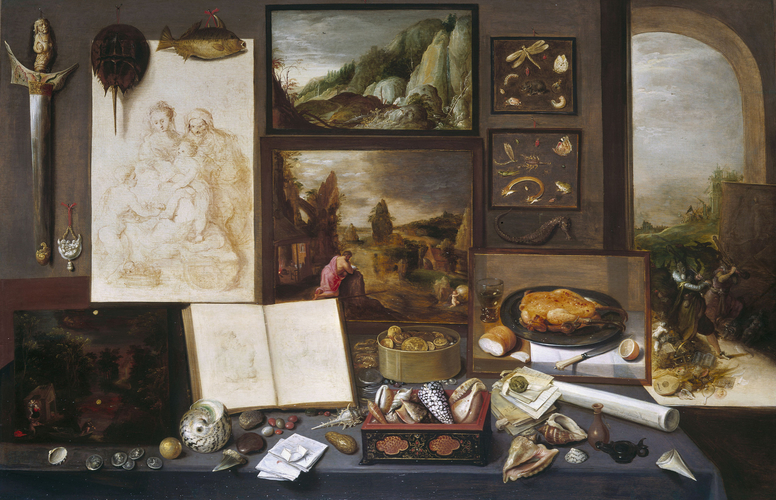
A similar painting by Frans Francken the Younger is in the Royal Collection entitled The Cabinet of the Collector which he completed around 1617. Amongst the paintings on view in the kunstkammer is a landscape by Joos de Momper, a still life of an everyday table set for a meal; and a small, nocturnal Flight into Egypt. Other religious painting depicted are one featuring St Augustine who is trying to comprehend the idea of the Trinity and sees a baby struggling to pour the entire sea into a pool in the sand with a shell – both tasks being equally beyond the scope of man. The drawings, one framed and one in an open book are two studies for Michelangelo’s Sistine ceiling and a preparatory drawing for Raphael’s Madonna della Perla which emphasise the intellectual side of painting.. There are also letters on the table, no doubt signifying an intelligent characteristic of the painting’s owner. Also displayed are exotic weaponry which is a reminder of the importance of travel and trade and a handful of Roman coins and a bowl of modern ones, which were not anything to do with wealth but more likely a celebration of the achievements of great men.
For me, the most interesting part of the work is seen beneath the arch to the right. In the background a church is demolished and nearby donkey-headed men with cudgels destroy a pile of objects associated with learning, science, the arts and sport. According to Karel van Mander, the sixteenth century Flemish poet, painter and art historian, a man with a donkey head is a symbol of Ignorance. The episodes depicted here recall two historical events: the Beeldenstorm, an outbreak of iconoclasm carried out by Protestants in 1566; and the ‘Spanish Fury’, the sack of Antwerp in 1576.
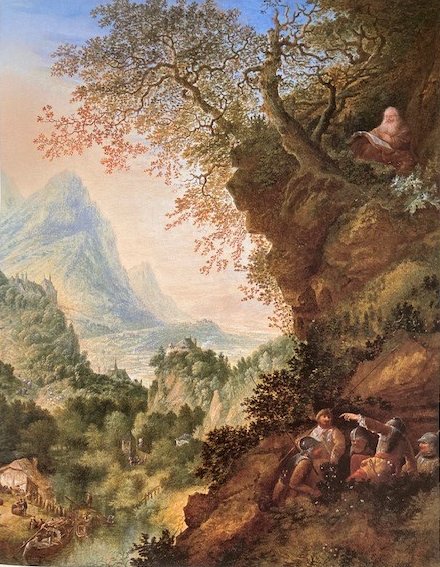
Jan Griffier the Elder, who was born in Amsterdam around 1645, was a painter and printmaker, who produced views of Rhineland landscapes as well as spending time, around 1660, in England where he produced many landscape works featuring the English countryside. One of his most beautiful landscapes is referred to as A Rhineland Landscape with a Hermit and Soldiers. The painting dramatically depicts a steep mountain landscape with a meandering river below which slowly flows through wooded crags which are surmounted by castles. If we look to the left foreground, we can see a men loading barrels of wine onto a small boat. The main figures in this painting are on the right-hand side. We see a group of soldiers lying down, concealed among the ferns and flowers. One of the group points down to the boat which is being loaded. Are they planning to raid the operation? Above them, sitting on a rock by a large oak tree in peaceful isolation, is a hermit, who is meditating. It is an interesting painting with plenty to focus on, but what is it all about ?
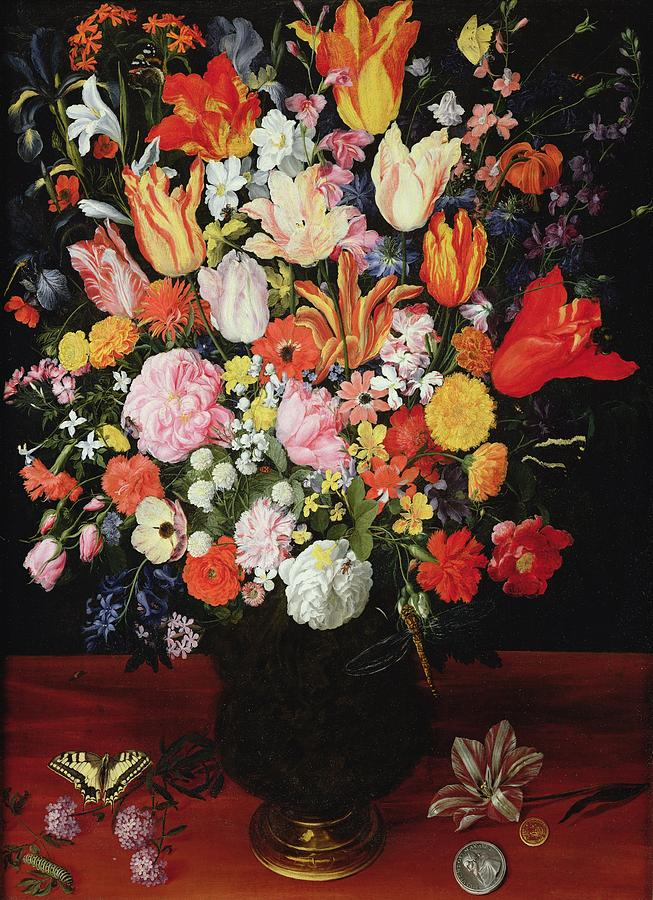
There is something that fascinates me about floral still life paintings. I think it is just the effort and patience the artists must have put in to produce such beautiful works. My next featured painting is a small (70 x 50cms) floral still life attributed to the Flemish Baroque painter, Gaspar van Hoecke, who was born in Antwerp around 1580.
Gaspar van den Hoecke was best known for his small religious cabinet pieces but during his early period around 1610 his work focused on still life floral paintings. The vase of flowers sits on a wooden tabletop. This dense grouping of flowers fills almost two thirds of the painting. The profusion of flowers doesn’t allow the artist to depict twigs and leaves between individual flowers. On the table we see a caterpillar of the swallow-tailed butterfly which is next to it. Also on the table there is a silver medal with the head of Pope Pius V which had been created in 1571. Just above it is a gold coin which is a rare example of a byzantine solidus made during the era of Anastasius, the Eastern Roman Emperor.
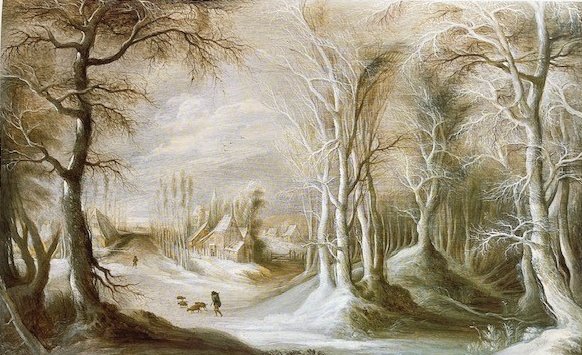
The Flemish painter Gijsbrecht Leytens was born in Antwerp in 1586. As a teenager, he began his apprenticeship with Jacob Vrolijck. In 1611 he joinied the Antwerp Guild of Saint Luke as a master. In 1615 he became a member of the Olijftak, a chamber of rhetoric that dates back to the early 16th century in Antwerp, when it was a social drama society which drew its membership primarily from merchants and tradesmen and provided public entertainment at prestigious events. Gijsbrecht was a captain in Antwerp’s Civic Guard between 1624 and 1628. His work followed the style of 16th and 17th century Flemish and Dutch great landscape paintings, which had brought recognition to such masters as Pieter Brueghel the Elder, Hendrick Avercamp, Gillis Van Coninxloo, Joost de Momper and Denijs Van Alsloot.
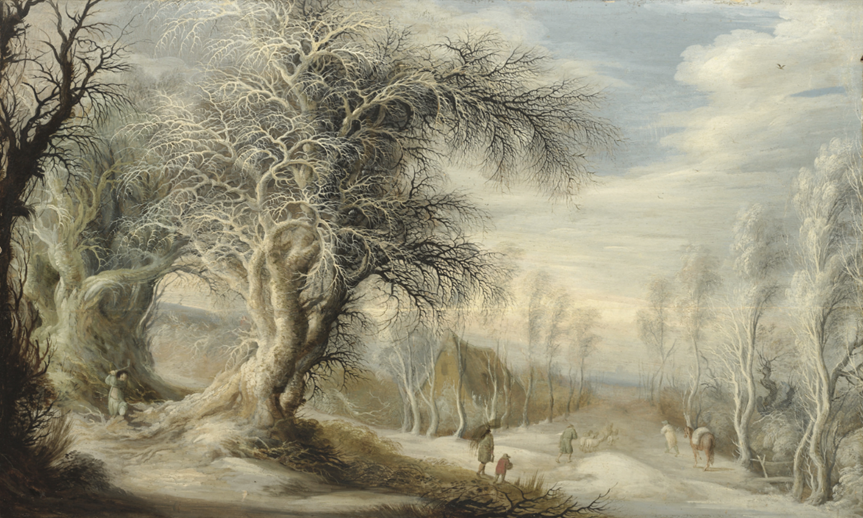
However, it was Gijsbrecht Leytens’ determined personal style that brought him to the public’s attention. Many of his paintings were simply attributed to “The Master of the Winter Landscape” and only in the 1940’s attributed to him. Leytens has an easily recognisable style not just because he focuses on snowy winter scenes but because of the way he depicts intricate and curious intertwining designs created by the bare branches and twigs which form a large part of his depictions. He was described as a poet of the frost in the way he conveys the cold nakedness of the sun on a countryside caught in the ice. No-one before him, nor after him, either in Flanders or elsewhere, expressed this with such intensity. The fundamental and unique quality of his art also resides in the extreme refinement of the subtle colour harmonies apparent in his paintings at all times.
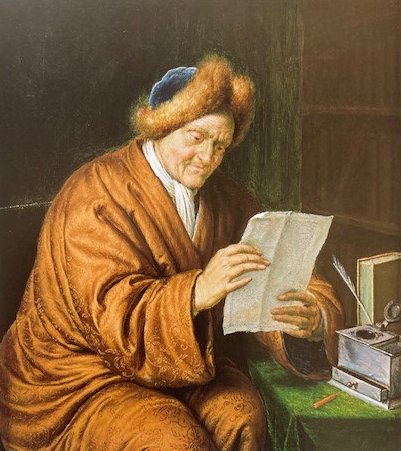
The depiction of the reading of a letter has featured in many paintings over the years. Such attention to what is written in the letter adds to the back-story of the artwork and often our imagination runs riot as we try to fathom out the sentiment expressed in the pages of the letter. My next painting is one by the Dutch artist Willem van Mieris who was born in Leiden in the Northern Netherlands in June 1662. His artistic tuition came from his father Frans van Mieris who was a genre painter. Throughout his career Willem was successful and had the support of a number of patrons who constantly supplied him with commissions. He was equally at home painting genre scenes and portraiture as well as being a skilled landscape painter, etcher, and draughtsman. He was the active leader of, and once became dean of, the Leiden Guild of St. Luke in 1693. A year later, in 1694, he established a drawing academy in Leiden along with the painter Jacob Toorenvliet.
In this work we see an elderly gentleman seated at a table in a darkened interior deep in concentration as he reads a handwritten document. He wears an opulent-looking gown which is made of richly embroidered material and which is evocative of the fashion for Japanese dress at the time. Upon his head is a hat made of rich blue velvet and lined with a extravagant swathe of fur. In the dark background we can just make out shelves filled with books. Couple that with the paraphernalia on the table, such as an inkwell, sealing wax and quill pen tells us that this a gentleman of great learning, maybe a lawyer. Lawyers were often depicted in paintings reading documents and letters.
I hope this blog will encourage you to delve into the world of Dutch and Flemish painters where you will find so many talented artists.






More Stories
Calvin Klein Biography
Celtic Art In Cross Stitch – Basic Medieval Stitch Designs & Instructions
Website Design and Development: A Science and an Art